Ever wondered about the dazzling figures commanding ancient Japanese stages? Kabuki actors, often misconstrued simply as entertainers, are, in fact, pivotal cultural custodians, embodying centuries of tradition and shaping the very narrative of Japanese history.
These performers, more accurately known as kabuki actors, are the lifeblood of kabuki, a theatrical form renowned for its stylized dance, music, and drama. Kabuki is not merely entertainment; it's a cultural institution. The elaborate costumes, the meticulously applied makeup, and the breathtaking stage sets are integral components, each contributing to a performance that transcends simple storytelling. Its a deeply codified art form, passed down through generations, demanding unparalleled dedication and precision from its practitioners.
| Kabuki Actor Profile | |
|---|---|
| Area of Expertise | Kabuki Theatre Performance |
| Role | Preserving and performing traditional Kabuki arts |
| Training | Years of rigorous training from a young age, specializing in music, dance, and drama. |
| Skills | Mastery of Kabuki techniques, including stylized movements, vocal projection, and the application of traditional makeup. |
| Period of Activity | Edo Period (1603-1868) to Present |
| Historical Significance | Popular figures during the Edo period, often commissioned for special events and performances at the Shogun's court. |
| Legacy | Keepers of a unique and traditional art form, representing skill and artistry of Japanese culture. |
| Dress Code | Known for wearing elaborate and vibrant costumes |
| Makeup | Makeup designs used for unique characters and roles |
| Official Kabuki Website |
- Recall Alert What Kind Of Ramen Was Recalled Nissin Info
- Fact Check Angelina Jolie Rip Death Rumors Debunked


